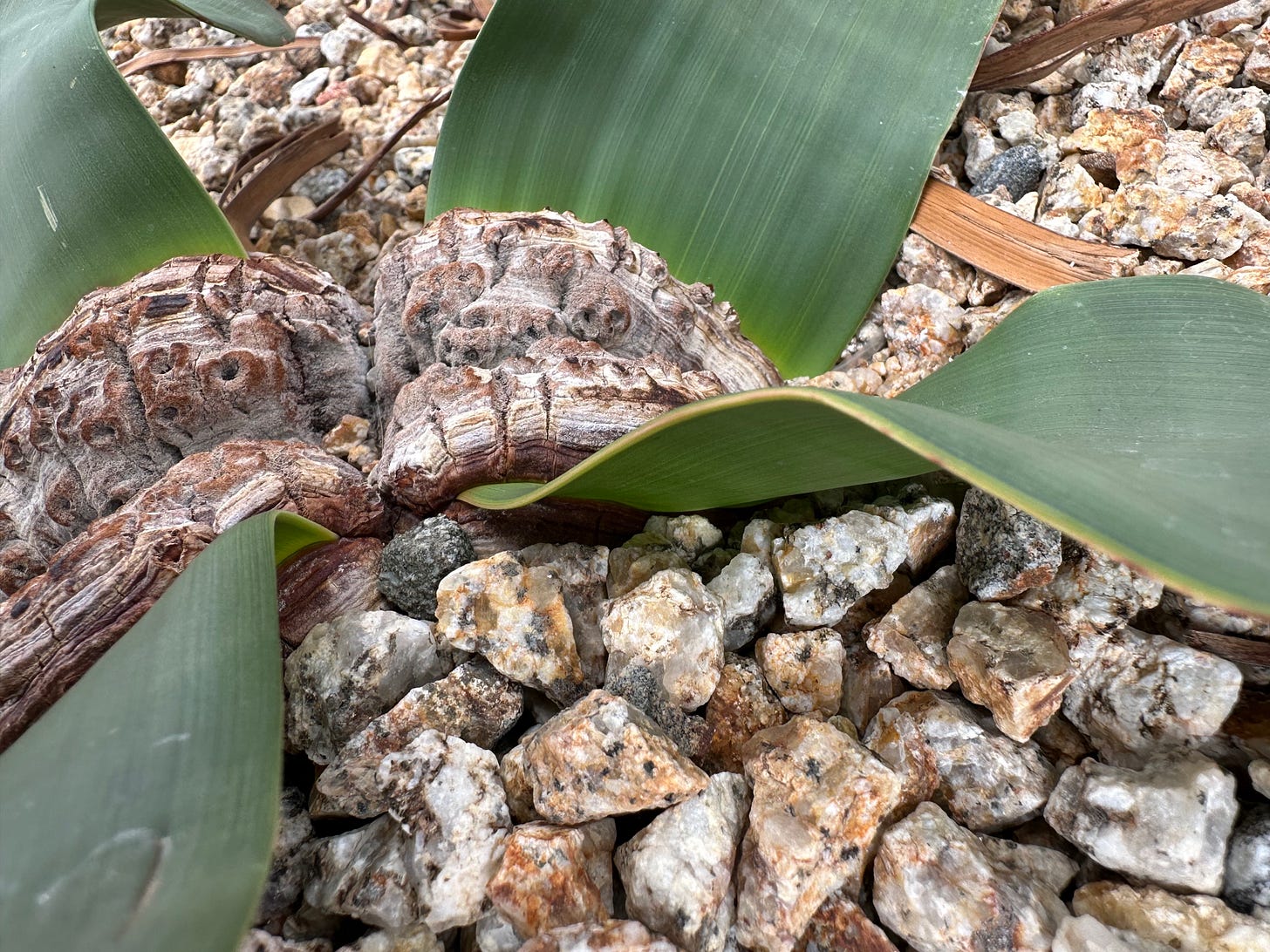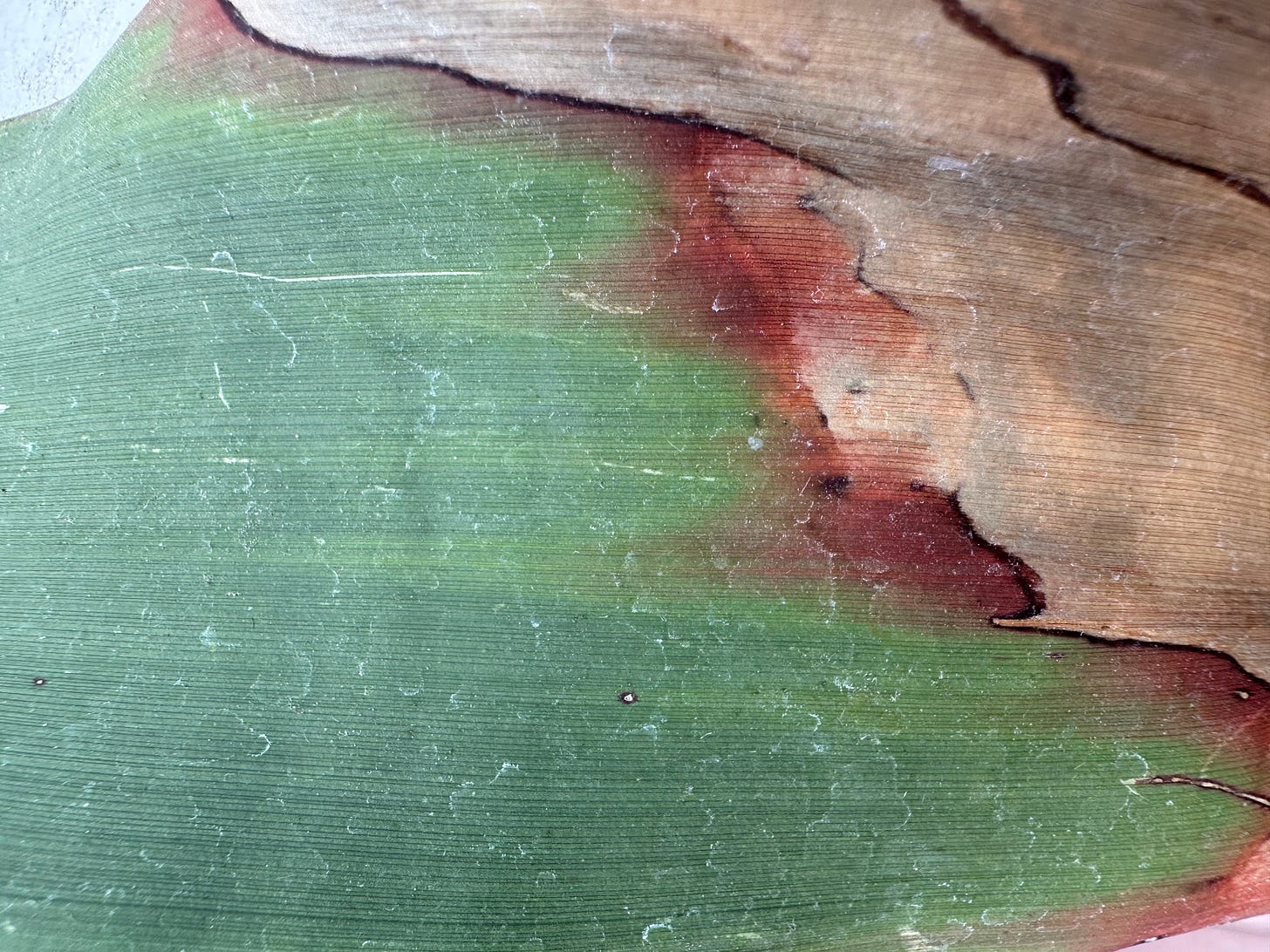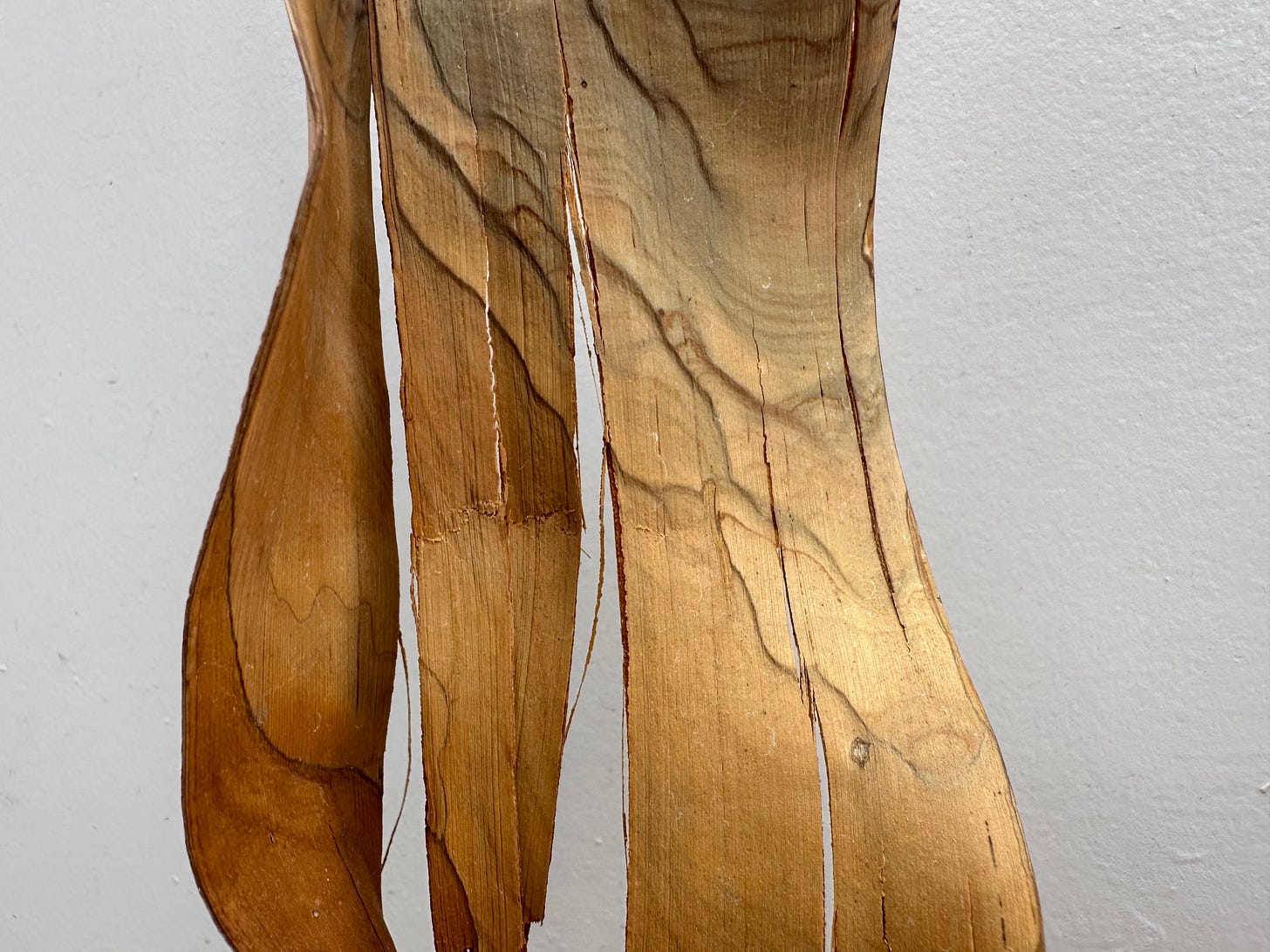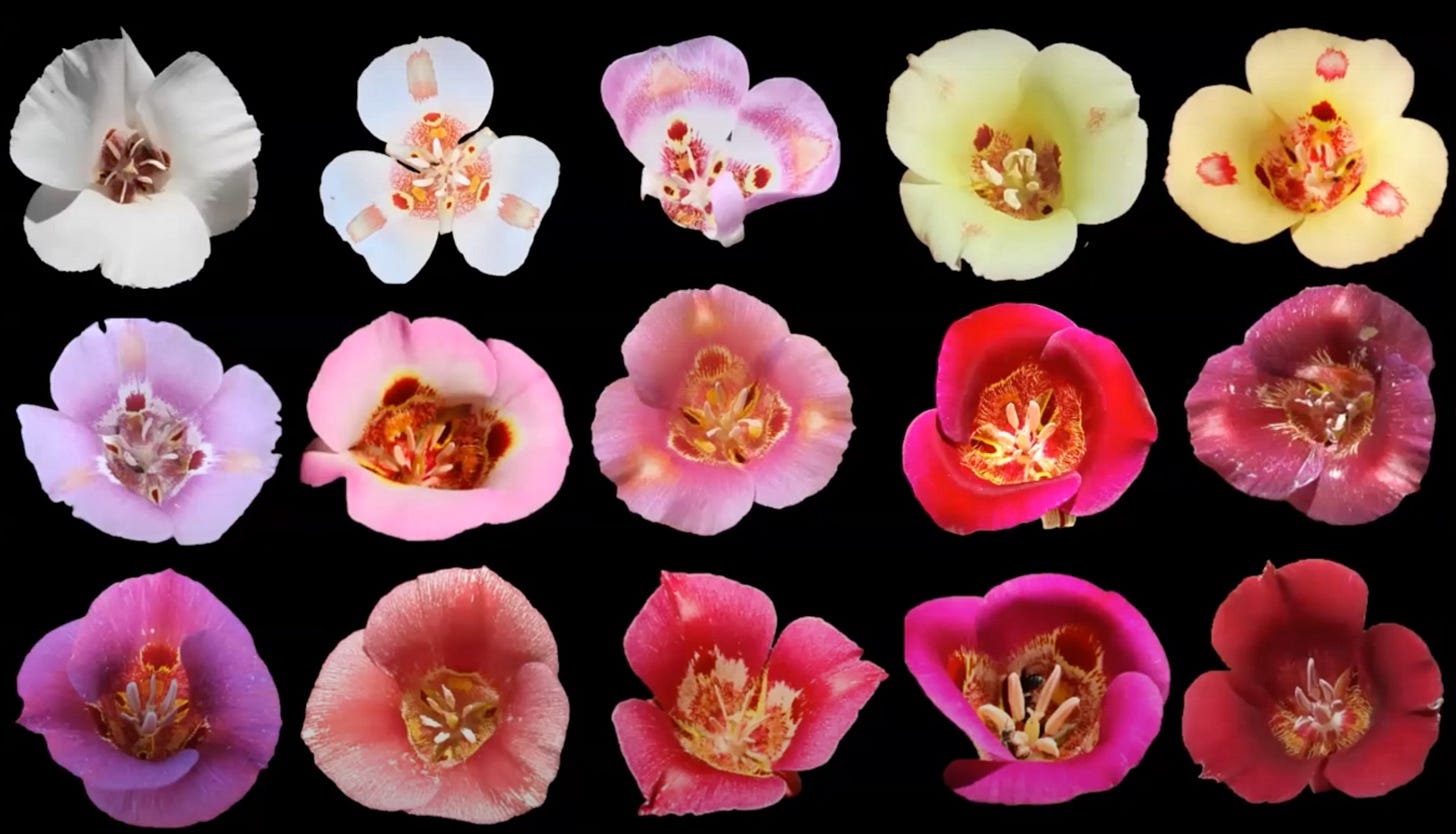2000 Seconds with Welwitschia mirabilis
What you notice if you stare at one of the stranger plants on Earth for a really long time
Weltwitschia mirabilis is one of the most amazing plants in the world. Found only in the Namib Desert, it can live 1500 to 2000 years. The plant grows two leaves and two leaves only in its life, but they keep growing and piling up near the central crown like old fax machine paper around an unattended machine. It is not only alone in its genus, but also its family. Even scientists publishing papers about the plant say that its genetics and ancient relatives “allow us to regard the extant Welwitschia as a living fossil.” We’re talking about a plant whose relatives flourished when Brazil and Africa were still connected.
Back in the 19th century, the Europeans lost their minds over the existence of this plant, publishing voluminous (and casually racist) correspondence about it. No one had ever seen a plant like it, either in its form or its function. “Indeed I have been assured by those who remember it,” wrote the director of London’s Kew Gardens, J.D. Hooker in 1862, “that since the discovery of the Rafflesia Arnoldii, no vegetable production has excited so great an interest as the subject of the present memoir.” You may know R. arnoldii as the corpse flower, which was reported in European literature in 1818, so… that’s the level of plant we’re talking here with Welwitschia.
For all these reasons, in a recent Cuttings section, I put a link to the New York Times story about the publication of the Welwitschia genome. And delightfully, a reader (landscape architect Nico Wright) left a comment about a local W. mirabilis: “There is a Welwitschia housed in the greenhouse at the UC Berkeley Botanical Garden, it has it's own special box of soil. Its leaves spread off the box and onto the floor. Apocryphally, a maintenance staff once ‘trimmed’ its leaves thinking they were waste on the floor, cutting literal decades of growth away.”
I had to go see it. But it felt like a pilgrimage, some kind of ritual visit. I decided, in honor of its long life, to observe it and it alone for 2000 seconds, a little more than half an hour. I hiked up there, wiped the sweat from my brow, and entered the greenhouse.
The plant sat there, alone, in its box, just as Nico had described.
I approached and stared down at the crown. In Hooker’s description of the plant, he described it as “dark brown, hard, cracked over the whole surface (much like the burnt crust of a loaf of bread.” It was beautiful, these two strange lobes with that mysterious cavity. This was an organism that seemed to exist between the kingdoms. It had a fungus-like quality, especially in the layers at the edges, one of those mushrooms you find in the forest attached to a log. But the crust of the crown also looked soft, lichen on rock. For me, it also suggested the body of a strange insect, a caterpillar that sprouted green wings without the full metamorphosis. I’d never seen anything quite like it.
The botanical drawings from Hooker’s cohort show that the plant’s core extends underground. What we see at the surface is just the tip of an extended buried plant body buried.
The insertions of the leaves are particularly odd. They just disappear into the core, like some belt in a machine, hardly seeming like part of the same organism. The color right near the core caught my eye, too: defiant, electric green.
As I stood staring, more things that were not Welwitschia came to mind. A bivalve, a scallop specifically. The leaves had the scratches and pockmarks of a battle-hardened gray whale. Their undulations were like frozen waves. How could this desert plant pull me oceanic? Survival and slowness. To live at the bottom of the ocean or in the middle of a desert takes a particular kind of slow force, an unimaginable patience for gathering the necessities of life.
By 1000 seconds with this plant, I was ready to scream: Move! Do Something! Be more than just alive! But it was quiet. Today, based on the estimates I saw, it might grow half a thousandth of an inch. But no plant will grow if you watch it, and in that, Welwitschia is no different.
I began to inspect the interface between life and death in its own leaves. There is a border there, a demarcating line of still-existing and once-existed. But like any border, there is a bleeding over. It is, appropriately, actually red. I would love to see the cells from that region and to know how they differ from those up or down the leaf.
The truly dead parts of the leaves might be the most beautiful of all, settled into another visual confusion caught between landscape and tree ring.
It was strange to realize I had been staring at the same plant for 20 minutes, the fans whirring in the greenhouse, grow light glowing, when finally, I noticed some movement. The tiniest flapping of a leaf end in the interior breeze.
At 1700 seconds, I thought: maybe I’ll leave before my allotted ritual time. Who would know? But I was held there, leaning over the box, inspecting. Circling the plant, there, on the floor, were pieces of the old leaves, broken bits. This was probably as it should be. It doesn’t make sense to be too precious about the dead parts of a being that lives in the most hostile environment a plant can imagine. But also: fragile. This creature has been stuck here in the botanical collection since the 1950s, now in this box in a special humidity controlled room, living forever by our standards, but also dying slowly, as everything is.
CUTTINGS
If you like Calochortus, you have got to watch this talk by Adriana Hernandez on Calochortus venustus. Shout out to reader Peter Repetti for sending it to me. Just look at this slide: this is all one species!
You want to sign up for East Bay Yesterday’s newsletter. Liam’s last letter was filled with the most interesting artifacts — including new EBY x Oaklandish merch! I got the Key System dad hat.
Oakland’s Demondre Ward is probably my favorite street photographer. Dude just has incredible skill and empathy. He’s got a zine out he’s calling a “prologue” to his forthcoming book HOME IS HOME.
Supposedly, the Jimmy Nardello pepper originated with the Nardello family of Naugatuck, Connecticut. But who was Jimmy? I found a person—James Thomas Nardello—matching the description given in most stories about the pepper’s provenance. Ancestry’s Census, military, and death records indicate he lived his whole life at 516 S Main St, Naugatuck, CT. He was 5’3” and worked for the US Rubber Company. His wife, Winifred, was a wrapper at a candy factory. As far as I can tell, there’s no mention in the contemporary record of the Nardellos as gardeners. They were known, however, as union men in the local.
Consider this essay in The Trumpeter by Janice Vis, “Cactus: Thoughts on Home, Grammar, and Personhood”. A good question to keep in mind:
“how might a writing practice
bring me into more ethical
relationships with this place?
and/orCactus?”
Send me cuttings!! Reply to this email, leave a comment, or email alexis.madrigal@gmail.com. The button below commands it.












I know that a lot of plants can live a really long time but I found it fascinating that this plant out of all plants can live to be 1500-2000 years old. Plus, I could not for the life of me have the patience to sit and stare at a plant for, like, 35 minutes without looking at everything else.
What a fantastic post -- I've been in the cactus house only once, always ending up wandering and enjoying the rest of the garden, forgetting the housed treasures. I'm definitely visiting the Welwitschia next visit!